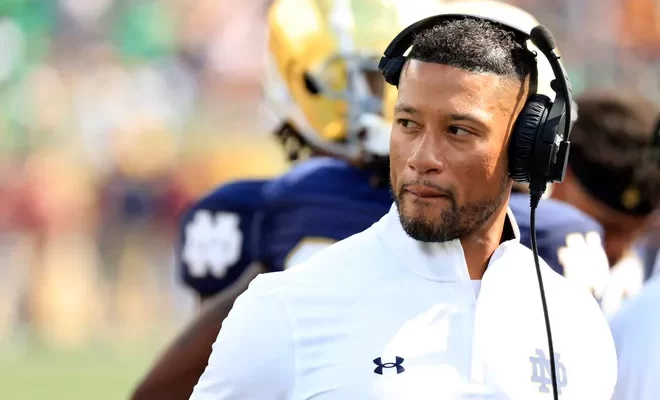Marcus Freeman Faces the Daunting Challenge of Rebuilding Notre Dame’s Elite Defensive Line Talent Pipeline.
When Marcus Freeman took over as the head coach at Notre Dame in December 2021, he was already viewed as a rising star in college football. A young, dynamic leader with a sharp defensive mind, Freeman had won over fans and recruits alike during his brief tenure as the Fighting Irish’s defensive coordinator. His promotion brought with it tremendous hope—not just for sustained success, but for a new era of dominance. Yet as the 2025 season approaches, Freeman finds himself grappling with a crucial challenge that strikes at the core of Notre Dame’s identity: the need to rebuild its elite defensive line talent pipeline.
Historically, Notre Dame has boasted some of the nation’s most formidable defensive fronts. From Alan Page and Ross Browner to Justin Tuck and Stephon Tuitt, the Irish have long prided themselves on producing NFL-caliber linemen capable of anchoring top-tier defenses. In recent years, however, the program has struggled to consistently stockpile that level of talent. Now, with new expectations and national championship aspirations under Freeman, replenishing the defensive line is not just a goal—it’s a necessity.
When Freeman arrived in South Bend in 2020 as defensive coordinator under Brian Kelly, he inherited a strong, veteran defensive line unit. That group, led by players like Myron Tagovailoa-Amosa, Kurt Hinish, and Isaiah Foskey, gave Freeman a solid base from which to install his aggressive, attacking defensive scheme. In 2021 and 2022, the Irish fielded defenses that were physical, disciplined, and often dominant at the point of attack.
But while those units had experience and savvy, they also reflected a recruiting pipeline that had started to slow. Although Foskey emerged as an elite pass rusher and a second-round NFL Draft pick, Notre Dame was not consistently landing top-tier blue-chip linemen at the same rate as programs like Georgia, Alabama, or Ohio State. That disparity began to manifest in depth concerns, particularly in rotational quality and long-term player development.
Freeman, known for his recruiting acumen, immediately sought to change that trajectory. But rebuilding a pipeline is not a one-year project—it requires sustained investment, strategic vision, and a little bit of luck.
Rebuilding any position group in modern college football is complicated by the realities of the NIL (Name, Image, Likeness) landscape. For Notre Dame—an academically rigorous institution that doesn’t always engage in the flashiest NIL practices—competing for five-star talent, especially in the trenches, is more difficult than ever.
Defensive line prospects are some of the most coveted players in the country. Elite interior linemen and edge rushers are often pursued by every powerhouse school with the full backing of lucrative NIL collectives. Freeman and Notre Dame’s staff have had to strike a careful balance—prioritizing players who fit the program’s culture and academic profile while also competing for talent in a rapidly shifting market.
Despite these challenges, Freeman has shown promise. His 2023 and 2024 recruiting classes featured some intriguing prospects, such as Brenan Vernon, Boubacar Traore, and Armel Mukam. While these players have potential, none were universally regarded as program-changing recruits in the mold of a Chase Young or Myles Garrett. More troubling, perhaps, is the fact that Notre Dame has missed on several of its top defensive line targets over the past two recruiting cycles—players who ended up at SEC schools or in Big Ten powerhouses.
In addition to acquiring talent, Freeman must ensure that once prospects arrive in South Bend, they are properly developed and retained. Player development has long been a strength for Notre Dame’s program, but the volatility of modern rosters—due to the transfer portal and NIL opportunities—has made continuity harder to achieve.
Notre Dame has seen several promising defensive line recruits transfer before reaching their potential. Others have taken longer to develop physically, requiring multiple seasons before they become contributors. This has left the Irish thin at times, particularly when injuries strike or veterans leave early for the NFL.
Freeman and defensive line coach Al Washington have emphasized strength training, technique refinement, and mental preparation as pillars of development. Still, the results have been uneven. In 2024, for instance, the Irish defense was stout against the run but lacked consistent pass-rushing firepower outside of situational blitzes. Without a game-changing presence on the edge, Notre Dame struggled to impact elite quarterbacks in high-stakes games—a critical weakness that underscored the importance of elite line talent.
Another complicating factor in the rebuilding process is scheme compatibility. Freeman’s defensive philosophy emphasizes versatility, movement, and aggressive front alignments. It’s not just about plugging space-eaters into gaps; he wants linemen who can penetrate, disrupt, and shift across multiple fronts.
This vision requires a specific kind of athlete—long, explosive, and cerebral. While many high school linemen possess raw tools, relatively few are ready to play within Notre Dame’s complex defensive schemes right away. Freeman and his staff are thus tasked with not only identifying talented players but finding those who can thrive within their system and grow over time.
To address this, Notre Dame has begun placing more emphasis on multi-positional athletes and hybrid defenders. They’ve also expanded their recruiting footprint, targeting players from talent-rich areas such as Texas, Florida, and the Southeast. But again, competing in these regions often puts them head-to-head with NIL-heavy programs that can offer immediate financial incentives
Looking ahead, the 2025 and 2026 recruiting classes will be critical litmus tests for Freeman’s efforts to rebuild the defensive line. Early signs are mixed. While Notre Dame is in the running for several high-profile defensive linemen, it remains to be seen whether they can close the deal.
Freeman has made personal inroads with key recruits, often taking a hands-on approach and emphasizing Notre Dame’s combination of academic prestige, national exposure, and NFL development. He has also leveraged the program’s storied tradition and alumni network, highlighting the success of former Irish linemen in the professional ranks.
Yet closing on top-tier talent requires momentum—and in college football, momentum often follows wins. A breakthrough season, especially one that features dominant defensive line play, could change the perception of Notre Dame’s line room among elite recruits. Conversely, another season with middling sack numbers and limited disruption could reinforce doubts about the program’s ceiling.
While Freeman builds for the future, he must also address the present. The transfer portal has emerged as a valuable tool in supplementing the roster, and Notre Dame has shown a willingness to engage when the right fit is available.
In recent offseasons, the Irish have explored portal options for plug-and-play linemen, especially interior defenders who can contribute right away. This approach has had some success, but again, Notre Dame’s institutional approach limits the pool of eligible players due to academic requirements and cultural fit.
Still, expect the Irish to remain active in the portal moving forward—especially if recruiting misses continue or development timelines prove too long. Freeman knows that championship teams are built in the trenches, and he cannot afford to wait three seasons for every recruit to develop.
For Marcus Freeman, the challenge of rebuilding Notre Dame’s elite defensive line isn’t just about fixing a position group. It’s about laying the foundation for a program that can compete with the nation’s best on a consistent basis.
Great defenses begin up front. They control the line of scrimmage, dictate tempo, and make life miserable for opposing quarterbacks. Without a dominant front, even the best secondaries and linebacking corps are exposed. Freeman understands this truth as well as anyone—and his legacy at Notre Dame may well hinge on whether he can construct a defensive line that strikes fear into opponents once again.
In many ways, the task ahead is emblematic of the broader mission Freeman faces as Notre Dame’s head coach: modernizing a historic program without compromising its core values. That means navigating the murky waters of NIL, battling blue-blood competitors for talent, and maximizing every ounce of potential from the players who commit to the Irish.
It also means being relentless—on the recruiting trail, in the weight room, and in film sessions. Freeman’s energy and passion have already infused the program with a new sense of purpose. Now he must translate that momentum into the trenches, where games are won and lost.
If he succeeds, Notre Dame won’t just return to national contention. It will reclaim its identity as a place where defensive linemen become legends. And Marcus Freeman will have built more than a pipeline—he’ll have built a wall



